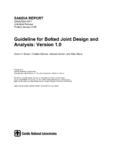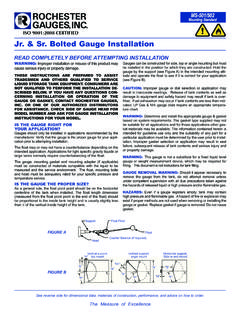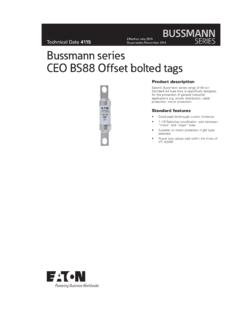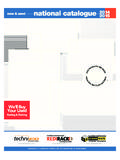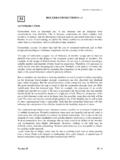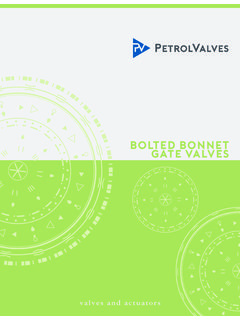Transcription of Design and Analysis of Bolted Joints
1 Design and Analysis of Bolted Joints for Aerospace Engineers Short Course Help you understand how to Design Bolted Joints that Objectives: Audience: Mechanical Design engineers Structural analysts Others interested in the Design of Joints function as required are relatively inexpensive and easy to assemble are trouble-free Share traditional methods of Analysis and help you understand when they apply and why they are effective Help you understand NASA s new standard for threaded fastening systems, NASA-STD-5020 (released in March 2012) Provide a valuable reference and a trail to data sources Design and Analysis of Bolted Joints July 2013 Copyright Instar Engineering and Consulting, Inc. Materials may be reproduced in complete form only, with header and footer Course developed and taught by Tom Sarafin Course Sampler Design and Analysis of Bolted Joints July 2013 Copyright Instar Engineering and Consulting, Inc.
2 Materials may be reproduced in complete form only, with header and footer Course Sampler DABJ History First version developed in 1998 at the request of NASA Goddard Titled Design and Analysis of Fastened Joints (DAFJ); 8-hour course, taught twice in 1998 Revised into a 16-hour course in 1999 Taught 21 times in this format; course materials revised (improved) after nearly each class Revised into a 24-hour course in 2005 at NASA JSC request to include a section on compliance with NSTS 08307 and other NASA standards This exercise included several meetings with JSC experts; all concluded that NSTS 08307 should be revised or replaced Helped fuel the NASA-STD-5020 project (new standard for threaded fastening systems), which started in 2007. Tom Sarafin served as one of the core team members for this project. Course renamed Design and Analysis of Bolted Joints (DABJ) Taught 19 times in this format, with periodic revision to capture additional information Major revision in June 2010 to include a section on Analysis criteria per the draft NASA-STD-5020, which was being developed at that time Taught 10 times between June 2010 and March 2012 Major revision in April 2012 to be consistent with the final version of NASA-STD-5020, which was released in March 2012 Taught 8 times as of July 2013 To date, Tom Sarafin has taught this course, in its evolving versions, a total of 60 times to more than 1200 engineers in the space and aircraft industries Design and Analysis of Bolted Joints July 2013 Copyright Instar Engineering and Consulting, Inc.
3 Materials may be reproduced in complete form only, with header and footer Course Sampler Course Topics of Designing Bolted Joints to Threaded Fasteners a Concept for the Joint Fastener Loads Modes and Assessment Methods Shear and Pull-out Strength Hardware and Detailing the Design of a Preloaded Joint Analysis Criteria Summary Design and Analysis of Bolted Joints July 2013 Copyright Instar Engineering and Consulting, Inc. Materials may be reproduced in complete form only, with header and footer Course Sampler Representative Fastener Issues on the Shuttle and Space Station Programs 1996 Space Shuttle mission (STS-80): A small screw with no locking feature backed out and jammed a gear in external airlock, preventing the astronauts from opening the hatch and performing the Extra-Vehicular Activity (EVA) part of the mission In a 2006 EVA, while astronauts tried to activate the Solar Alpha Rotary Joint on the International Space Station, a bolt in the launch restraint seized and required extremely difficult removal, injuring a crew member Multi-Purpose Logistics Module (MPLM): Hundreds of fasteners too short to fully engage threads and engage the locking feature, not detected during installation.
4 Running torque not verified for any of the fasteners used to assemble the MPLM. Space Shuttle Ku Band Antenna: After several missions, 2 of 4 main attachment bolts were discovered in 2006 to be too short to engage locking features or provide adequate strength; required risky repair on launch pad During a 2006 Shuttle mission, an EVA camera came loose and was lost because the mounting screws backed out Clearly the space industry needs to improve how threaded fasteners are used, controlled, and assessed! 1-5 Design and Analysis of Bolted Joints July 2013 Copyright Instar Engineering and Consulting, Inc. Materials may be reproduced in complete form only, with header and footer Course Sampler Designing a Bolted Joint 1. Identify functional requirements and constraints for the structure being designed Items to support, envelope, alignment 2.
5 Develop a concept Structural configuration and form of construction Method of attachment: welding, bonding, or fastening Concept for the joint: configuration, types of fasteners, access for assembly 3. Quantify requirements and identify Design considerations for the joint Life-cycle environments, Design loads, loading cycles, and temperatures Stiffness, allowable permanent deformation, and Design criteria Cost, lead time, ease of assembly, and schedule 4. Size the joint Select fastener pattern Calculate fastener loads; size fasteners Identify potential failure modes in the fittings and test-substantiated methods of assessment Size fittings 5. Select hardware and Design details Specific bolts, nuts, washers, pins Edge distance, wrench clearance, hole size 6. Specify assembly requirements Lubrication, installation torque, other 7.
6 Perform detailed Analysis Iterate as needed Goal: a joint that .. functions as needed throughout its intended life cycle uses affordable and available hardware is easy to assemble (and often disassemble) Where in course Sec. 1 Sec. 3 Sec. 1 Secs. 4 - 6 Sec. 7 Sec. 7 Secs. 8 & 9 1-6 Design and Analysis of Bolted Joints July 2013 Copyright Instar Engineering and Consulting, Inc. Materials may be reproduced in complete form only, with header and footer Course Sampler Comparison of Thread Forms (full radius) For critical bolts in flight hardware, use UNJ threads, and make sure they re formed by rolling after heat treatment (external only) A large root radius provides better fatigue life 60 60 60 no specified minimum radius rmin = rmax = rmin = rmax = UN (metric: M) UNR (no metric equivalent) UNJ (MJ) (Ref.)
7 5, SAE AS8879 controls the dimensions of the UNJ thread form but does not specify that the threads must be rolled after heat treatment) 2-8 Design and Analysis of Bolted Joints July 2013 Copyright Instar Engineering and Consulting, Inc. Materials may be reproduced in complete form only, with header and footer Course Sampler Designing Stiff Tension Joints Joint with high and relatively linear stiffness: Tension/compression walls aligned thick end pads high preload bolt tucked closed to tension walls P P Joint that is stiff in compression and flexible in tension (avoid): The thin flange, with bolts far from the tension walls, will bend and pry on the bolts Nonlinear stiffness makes it difficult to predict dynamic response or load distribution within the structural assembly P P Move bolts closer to tension walls and thicken the flanges washers to spread clamp load 3-9 Design and Analysis of Bolted Joints July 2013 Copyright Instar Engineering and Consulting, Inc.
8 Materials may be reproduced in complete form only, with header and footer Course Sampler Calculating Bolt Loads is Often Based Simply on Statics 1000 lb 1000 lb Case 1: Tensile applied load, with load vector centered between bolts Example: Tension joint with 2 bolts Case 2: Applied moment What s the peak bolt load? 1600 in-lb 1600 in-lb With loads carried only by the bolts, Super-position applies FBD Ignoring preload .. What s the peak bolt load? 1000 lb 1000 lb 1600 in-lb 1600 in-lb Case 3: Combined loads What s the peak bolt load? 4-7 Design and Analysis of Bolted Joints July 2013 Copyright Instar Engineering and Consulting, Inc. Materials may be reproduced in complete form only, with header and footer Course Sampler A Bolt that Failed in a Tension Test Shear at 45 degrees from the tension Full-diameter body (unthreaded portion of shank) The threaded region between the nut and the body is often quite short.
9 Failure exhibits more ductility if the body undergoes plastic deformation before rupture occurs at the threads. Thus, the most robust bolt is one made of a material that has a large difference between its proportional limit and its ultimate strength. This is not the case with ultra-high-strength fasteners and 160-ksi titanium fasteners. 5-5 Design and Analysis of Bolted Joints July 2013 Copyright Instar Engineering and Consulting, Inc. Materials may be reproduced in complete form only, with header and footer Course Sampler Bearing Ultimate Failure for Ductile Materials The material can undergo very large plastic deformation, elongating the hole. Rupture is typically shear tearout. 5-20 Design and Analysis of Bolted Joints July 2013 Copyright Instar Engineering and Consulting, Inc. Materials may be reproduced in complete form only, with header and footer Course Sampler Design Shear Joints to Be Bearing Critical Shear-critical joint: one that would fail first by fastener shear Can have little plastic deformation before failure The highest-loaded fasteners can fail before the others take their share of load Result: the joint can unzip , as each fastener next to a failed one becomes overloaded and then also fails Bearing-critical joint: one that would fail in bearing before the fasteners fail in shear Bearing failure is ductile, so the fasteners will share load before the joint fails Can t get a true bearing-critical joint with composites made of brittle materials With metal plates, Design the joint to be bearing-critical by increasing fastener diameter relative to plate thickness.
10 Even if the joint is bearing-critical, avoid long strings of fasteners in a splice, such as the one shown on the previous page. 5-31 Design and Analysis of Bolted Joints July 2013 Copyright Instar Engineering and Consulting, Inc. Materials may be reproduced in complete form only, with header and footer Course Sampler Class Exercise: Recognizing Potential Failure Modes (Problem 1) Materials: ductile metals A. Identify all potential ultimate failure modes of concern. B. Explain how you would assess those failure modes and obtain corresponding allowables. Spherical bearing P P C. How would you improve the Design ? 5-33 Design and Analysis of Bolted Joints July 2013 Copyright Instar Engineering and Consulting, Inc. Materials may be reproduced in complete form only, with header and footer Course Sampler Examples of Mismatched Hardware Bolt sizeBolt specBolt materialBolt mat'l ult tensile strength, Ftu (ksi)Bolt ult tensile strength, Ptu (lb)Nut or insertNut or insert specNut or insert materialNut or insert ult strength (lb)Minimum shear engagem area, in^2 Pullout strength in 6061-T651 (lb)Pullout strength in 7075-T7351 (lb)# #10 NAS1351A2861603200 NutMS21043A2862460#10 NAS6703A2861603620 NutNAS1291A2862460#10 NAS6703A2861603620 NutNAS1805A2864070 3 3/8 NAS1956A28618017100 NutNAS1805A28617100 3/8 NAS6706UA28616015200 NutMS21043A28611450 Some combinations in use in space programs (NASA survey results, Dec 2007).
